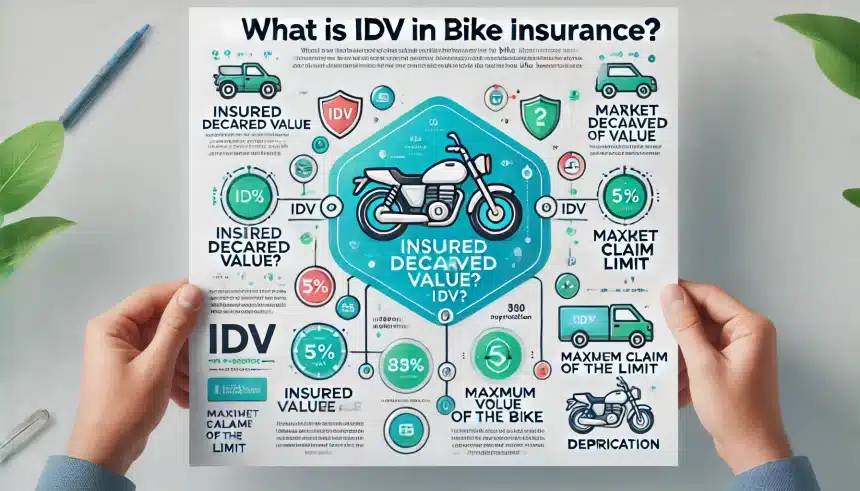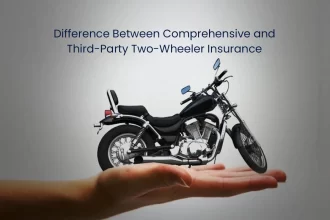When you purchase bike insurance, you may encounter several key terms that are essential to understand. One of the most important of these terms is IDV, which stands for Insured Declared Value. This value is a crucial component of your bike insurance policy because it directly affects your insurance premium and the compensation you would receive in the event of a total loss or theft of your vehicle. In this comprehensive guide, we’ll explore what is IDV in bike insurance means, how it’s calculated, why it’s important, and how it affects your insurance premiums.
Additionally, we’ll discuss other related concepts, such as depreciation and renewal, with examples to clarify.
IDV Meaning and Definition

IDV Meaning and Definition: Insured Declared Value (IDV) represents the maximum claim amount your insurance company will pay in case of a total loss or theft of your bike. Essentially, it is the current market value of your two-wheeler minus depreciation. The IDV is a critical element because it determines the amount of compensation you would be eligible to receive in the event of a complete loss of your vehicle.
The IDV is typically calculated by considering the ex-showroom price of the bike minus depreciation for age. It’s important to note that IDV is not the resale value of the bike but rather a calculated figure based on specific factors.
For example, if the ex-showroom price of your bike was ₹80,000, and after a few years of depreciation, the IDV of the bike is now ₹60,000, this amount represents the compensation limit you could expect in case of theft or total loss.
Understand IDV in Bike Insurance
To understand IDV in bike insurance, it’s essential to recognize how it plays a central role in determining your insurance coverage. As bikes age, they lose value due to factors like wear and tear, usage, and depreciation. Insurance companies use IDV as a reference point to establish the current worth of your bike, which directly impacts the premium you pay and the coverage provided.
For instance, the IDV will be higher for a new bike and decrease as the bike ages. If you have a newer model, the IDV might be close to the bike’s original price, while for an older model, the IDV might be much lower. IDV is reassessed each year during policy renewal to account for the depreciation of the vehicle.
Also read: Top 10 Bikes in India
What is IDV in Bike Insurance and Why is it Important?
Why IDV is important in bike insurance lies in its influence over both the premium and the amount you can claim. A higher IDV leads to a higher premium, while a lower IDV reduces the premium but also reduces the potential payout. Balancing these factors is critical to ensuring that you’re adequately covered without overpaying for insurance.
Consider this scenario: If you set your bike’s IDV too low to save on premiums, you may end up underinsured, meaning you won’t receive adequate compensation if your bike is stolen or damaged beyond repair. On the other hand, if you set it too high, you’ll be paying unnecessarily high premiums for coverage that might exceed the market value of your bike. Hence, choosing the right IDV is key to maintaining proper protection at a reasonable cost.
Two-Wheeler IDV: Rates of Depreciation
Depreciation plays a pivotal role in determining the two-wheeler IDV rates of depreciation. As bikes age, their value declines, and this decline is factored into the IDV calculation. The following table outlines standard depreciation rates:
| Age of Bike | Depreciation Percentage |
|---|---|
| Less than 6 months | 5% |
| 6 months to 1 year | 15% |
| 1 to 2 years | 20% |
| 2 to 3 years | 30% |
| 3 to 4 years | 40% |
| 4 to 5 years | 50% |
Once a bike is more than five years old, the IDV is generally determined based on mutual agreement between the policyholder and the insurer, taking into account the condition of the bike and market factors.
Also read: Is Insurance Mandatory for Bikes?
What is IDV in Bike Insurance: Calculation of IDV
The calculation of IDV is based on several factors. The most important is the bike’s ex-showroom price, which refers to the price before taxes, insurance, and other add-ons. After this, depreciation is applied depending on the age of the bike.
The formula for calculating IDV is as follows:
IDV = Ex-showroom Price – Depreciation
- For a bike less than six months old: 5% depreciation
- For a bike between six months and one year old: 15% depreciation
- For a bike between one and two years old: 20% depreciation
- For a bike between two and three years old: 30% depreciation
- For a bike between three and four years old: 40% depreciation
- For a bike between four and five years old: 50% depreciation
For example, if the ex-showroom price of a bike is ₹1,00,000 and the bike is two years old, the IDV would be:
IDV = ₹1,00,000 – 30% of ₹1,00,000 = ₹70,000
This ₹70,000 will be the maximum amount your insurance company would pay if your bike is stolen or damaged beyond repair.
Impact of IDV on Two-Wheeler Insurance Premium
The impact of IDV on two-wheeler insurance premiums is straightforward: the higher the IDV, the higher the insurance premium you will need to pay. Since the IDV represents the value of the bike, insurance companies calculate premiums based on the level of risk involved. A higher IDV indicates a more valuable bike, which is costlier to repair or replace, thus leading to higher premiums.
For example, if you own two bikes of different ages with different IDVs, the insurance premium will be higher for the newer bike with a higher IDV. In contrast, the older bike with a lower IDV will have a lower premium. It’s crucial to ensure that you’re choosing the correct IDV to avoid paying too much for insurance while ensuring you have sufficient coverage.
What is IDV in Bike Insurance During Policy Renewal
When renewing a two-wheeler insurance policy, the IDV during policy renewal is reassessed to account for the depreciation that has occurred over the past year. It’s essential to review your policy and adjust the IDV accordingly to ensure you’re paying the correct premium and receiving adequate coverage.
For example, if the IDV was set at ₹60,000 during the previous year, but your bike has aged further, the new IDV may drop to ₹50,000 or lower, depending on the depreciation rate. Adjusting this IDV helps ensure your insurance premium remains appropriate for the current value of your bike.
We’ve done our best to answer the question, ‘What is IDV in bike insurance?’. What topic would you like us to cover next? Let us know in the comments below!
For the answers to questions like how to buy a bike on EMI, what is third party insurance and comprehensive bike insurance, can you buy a bike using your credit card, and more, keep reading AUTOLIVENEWS blogs.
Frequently Asked Questions (FAQs)
What is IDV in bike insurance?
IDV stands for Insured Declared Value, which represents the current market value of your bike and is the maximum compensation you can claim in case of total loss or theft.
How is IDV calculated for a two-wheeler?
IDV is calculated by subtracting depreciation from the bike’s ex-showroom price.
Does IDV affect my bike insurance premium?
Yes, a higher IDV leads to a higher insurance premium, while a lower IDV results in a lower premium.
Can I change my bike’s IDV during policy renewal?
Yes, IDV is reassessed and can be adjusted during policy renewal to account for depreciation.
Why is IDV important in bike insurance?
IDV determines the compensation amount you would receive in case of total loss or theft and influences the premium you pay.
What happens if I set a low IDV for my bike?
While a low IDV reduces your premium, it also lowers the compensation amount, which may leave you underinsured in case of total loss.
Is IDV the same as the resale value of my bike?
No, IDV is not the resale value. It’s the bike’s current market value calculated by the insurer based on depreciation.
What is the depreciation rate used in IDV calculation?
Depreciation rates vary based on the age of the bike. For example, a bike that’s two years old typically has a 20% depreciation rate applied.
Can I negotiate IDV with my insurer?
You can discuss the IDV with your insurer, but it must fall within a reasonable range based on the bike’s age and condition.
What happens if my bike is older than five years?
For bikes older than five years, the IDV is typically agreed upon between the policyholder and insurer based on the condition and market value.















